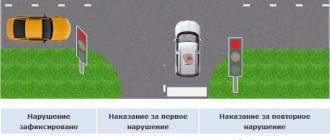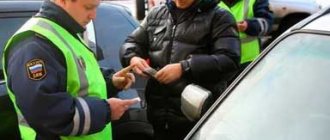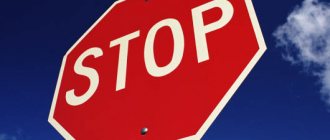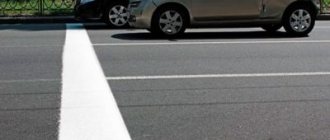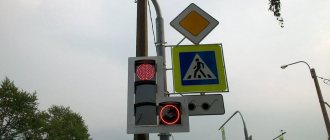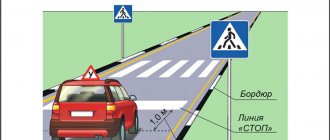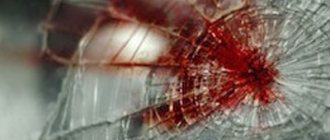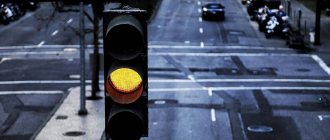Legal basis
Red and yellow lights mean you can't drive yet. Neglect of this prohibition entails administrative liability.
It is also considered a violation if the driver “did not notice” the stop line; driving through it is punishable by a fine of 800 rubles.
Actually, the situation when a violation was detected by a camera is no different from that noticed by a vigilant traffic inspector.
The only difference is in the penalties. The camera will not take away your license: the first time the driver will receive a notification demanding to pay a fine of one thousand rubles. If he continues to decide not to pay attention to the traffic light and this is recorded, then this is fraught with an amount of five times more (Article 12.12 of the Code of Administrative Offenses). But it’s a completely different matter if a guard catches you doing something like this. In this case, the car owner risks losing his license for up to six months.
There is a chance to get away with half the amount - that is, only 500 rubles (Article 32.2 of the Administrative Code), if you manage to pay the fine in the first twenty days after the official receipt of the notification (acceptance from the postman or at the post office). But this is only if the violation happened for the first time. Moreover, if the first time a person was recorded by a camera, and the second time he was spotted by a traffic inspector, then here, too, they will most likely be deprived of their license.
For drivers who do not understand the first time, the discount does not apply - a fine of five thousand for subsequent trips to red will have to be paid in full (Article 12.12, Part 3 of the Administrative Code).
Important note!
- This article provides basic information, but each case is different.
- In 92% of all situations there are important nuances that can affect the outcome of the entire case.
- An experienced lawyer will study all the materials of the case and indicate in which direction to move.
Therefore, our website employs on-duty legal consultants who delve into each case and are aimed at solving it.
Ask a Question
or consult toll-free (Moscow), (St. Petersburg), 8 (all of Russia).
If you get caught again
A repetition of a traffic violation occurs if it is committed within a year from the date of full execution of the first fine. Full execution means payment of a fine or the end of the period of deprivation of rights.
If for the first time under the camera you drove through a red traffic light, for example, on January 1, 2021, you received a letter with a fine on January 10, and you paid for it on January 20 (with a 50% discount), then until January 20 of the next year you You can’t get caught running red again.
For repeated driving on a red light, the punishment is much greater: a fine of 5,000 rubles or deprivation of rights for 4-6 months. This is provided for by Part 3 of Article 12.12 of the Administrative Code. But the main subtlety is that when a violation is automatically recorded on camera, there cannot be a deprivation of rights - only a fine.
Let us clarify that deprivation of rights cannot occur in the following cases:
- if both the first time and the second time you drove through a red traffic light under the camera,
- if for the first time you were fined by a traffic police officer on the road, and a second fine was issued by an auto-recording camera.
But if even the first time you were caught on camera, but the second time within a year you were stopped by a traffic police inspector on the road for passing a red flag, then there may already be deprivation.
In addition, a repeated fine for a red light in the amount of 5 thousand rubles will have to be paid in full in any case - it is not subject to a 50% discount (Part 3 of Article 12.12 of the Code of Administrative Offenses is cited as an exception to the list of “discount” fines in Part 1.3 of Article 32.2 of the Code).
Another fine for red on camera
It is rarely issued and is provided for driving through a prohibitory signal, not just a regular traffic light, but a railway one. Punishment for such a violation is provided for in Part 1 of Article 12.10 of the Code of Administrative Offenses and entails a fine of 1,000 rubles or deprivation of rights. But, again, they won’t be able to deprive you of it on camera.
Fines for other types of traffic lights
The same amount (namely, one thousand rubles) is established as a penalty for illegal passage through the railway (Article 12.10 of the Code of Administrative Offenses), in case the passage is recorded by a camera. But if a reckless driver is stopped by a traffic inspector, the car owner may lose the right to drive the car for up to six months.
For neglecting signals on reverse lanes, the fines are more severe - from 1,500 rubles.
Reversing traffic is regulated by signals other than on a regular road:
- red X-shaped - you cannot drive, this lane is intended for oncoming traffic;
- with an arrow pointing down diagonally - you cannot change lanes into this lane; oncoming traffic is not allowed;
- symbols turned off - prohibition of oncoming traffic.
Responsibility for neglecting reversible traffic lights is regulated by the provisions of Art. 12.15 Code of Administrative Offences. Driving through a red light at an X-shaped traffic light will result in a fine of up to five thousand rubles.
Fine for driving through a prohibitory traffic light in 2021
Article 12.12 of the Code of Administrative Offenses states that in case of driving through a red light or a traffic controller’s prohibiting gesture, a fine of 1000 rubles . The ban is imposed not only on red or yellow, but also on the transition from yellow to red, that is, on all prohibiting signals.
Moreover, you can still somehow get away from the fine for driving on yellow, because the law specifies that if you have to brake urgently when the prohibiting signal turns on, you can pass.
If the rule is violated repeatedly, then, according to Part 3 of Article 12.12, the driver will face a more severe punishment:
- increasing the fine to 5,000 rubles;
- deprivation of the right to drive a vehicle for a period of four to six months.
It must be remembered that the violation will be considered committed again if less than a year has passed since the payment of the fine.
If the driver passed the intersection when the permit signal had not yet come on, then this is also considered a violation. This applies to intersections where traffic lights with an additional section are installed. That is, if the green arrow does not light up, but the passage is made in the direction it regulates, then you can wait for a “letter of happiness”.
Driving on railroad tracks at a red light
The penalty for crossing the tracks is regulated by Article 12.10 (Part 1). The driver may face:
- a fine of 1000 rubles;
- deprivation of a driver's license for a period of three to six months.
Crossing the stop line at a red light
In case of driving to a controlled intersection beyond the stop line under a red signal, the driver will be fined 800 rubles (Part 2 of Article 12.12 of the Code of Administrative Offenses).
A stop line at an intersection can be indicated either by a line or a road sign; you can often find a combined version. Their meanings for drivers do not coincide in everything:
- the sign requires stopping only at an intersection controlled by a traffic light;
- The markings oblige drivers to stop at any intersections if there is a sign.
If you are accused of crossing the stop line, say that you were already close to it and it was not possible to stop without resorting to emergency braking, refer to Article 6.13.
I don’t have time to stop in time, what should I do?
According to traffic regulations, when there is a prohibiting signal, the driver must stop before the stop line. However, it may happen that a person does not have time to stop the car in the right place. In this case, you can do different things:
- Drive through a red light. The worst option. Not only will you be required to pay a fine of 1,000 rubles, but the maneuver is also very dangerous and can lead to an accident;
- Stop behind the line. This scheme is better because the maneuver is safer, and the driver will be fined a smaller amount (800 rubles);
- Return to the stop line using reverse. The driver will be issued two fines at once: for crossing the line (800 rubles) and for driving in reverse at an intersection (500 rubles). There is a high probability that another car is already standing close behind, and the one who used reverse gear will be to blame for the accident, since according to traffic regulations, there should be no interference with other vehicles when moving in reverse.
Traffic jam at the intersection
It often happens that a driver enters an intersection, and there is already a traffic jam there. According to the law, you cannot do this, even if the traffic light is green. After all, if a motorist does leave, he will become an obstacle for cars from adjacent roads. Such a violation is punishable by a fine of 1,000 rubles (Part 1 of Article 12.13 of the Administrative Code).
Running a red light under camera
Violations of traffic rules are recorded by traffic police officers or special cameras. Drivers are informed when approaching the camera by markings on the road or a special road sign. When driving under the camera, you need to remember that it monitors the speed and the correct passage of intersections.
Since 2021, cameras on the roads began to record the following violations:
- driving through a yellow light;
- driving through yellow and red traffic lights at the same time;
- crossing an intersection when the green light has gone out.
If a motorist violated traffic rules, and this was recorded by a camera, then the punishment will not differ from what if he was stopped by a traffic police inspector. The fine will still be 1000 rubles. In case of repeated violation, it will increase to 5 thousand.
According to statistics, if a violation is recorded by a camera, then the driver’s license can be taken away with a low degree of probability, since this is difficult to implement. Therefore, most likely the driver will simply receive a fine.
What cars can run a red light?
As it becomes clear, the red and yellow lights can only be interpreted in one sense - you can’t go further, you need to stop and wait for permission. But in some cases it is allowed to continue moving:
- if a car entered an intersection when the signal was green, but did not have time to cross it, the red signal turned on;
- the traffic controller's signal contradicts the traffic light - the guard's requirements take priority;
- to stop before the stop line, you need to brake urgently;
- conditions of extreme necessity.
The situation with the last point is ambiguous. The law requires that if, for example, a person was taking a victim to a clinic and the minutes were counting, then any liability is removed, and the proceedings initiated in the case are terminated (Article 24.5, Part 1 of the Administrative Code). But in this case, the car owner will have to prove his case in court.
Did he violate it, or did it seem like it?
OSAGO is out of focus: drivers again can not be afraid of cameras
Verification of compulsory motor liability insurance policies using cameras has been postponed again
One of these complexes became the reason for discussion on social networks on November 6. We are talking about a camera installed at the intersection of Nizhnyaya Maslovka and Raskova streets. Thus, according to information from the Blue Buckets society on Facebook, even those who drove through the intersection according to the rules, with a mandatory stop, received a “letter of happiness.” The ill-fated complex in the comments was quick to call it uncalibrated and the testimony unreliable. Users also noted the interval between the stop line on the asphalt and sign 2.5 (“Driving without stopping is prohibited”) and assumed that the camera was focused on the latter, resulting in false fines.
How does a stop line camera work?
The stop line is depicted on the roadway as a marking and is usually duplicated with a special sign.
If a car hits or crosses the stop line, this is considered a violation.
The camera does not take into account the marking line on the road itself, but special photo marks that are added to the camera device. If, for example, the solid stop line is removed, the camera will still see its photo marks and take photographs at the intersection of the invisible line.
What does a traffic police photo camera look like on the roads?
Drivers can already distinguish what the cameras that record the intersection of stop lines look like. They are usually placed on vertical posts or on horizontal trusses directly above the roadway.
Installed in places of complex road junctions, traffic jam intersections, emergency areas, etc.
It happens that they install dummy cameras on the stop line. It's cheaper, and attentive drivers already follow the rules. You just can’t visually determine whether the chamber is working or a dummy.
How the camera detects stop-line violations
Cameras are classified into:
- Stationary.
- Mobile.
Based on their design, cameras are classified into 3 types:
- Radar. These cameras determine the speed of vehicles and record speeding. Such a system can be detected by a conventional radar detector, which the driver installs to notify that a camera is nearby. The most powerful such system is Strelka-ST.
- Laser. Such cameras do not work well in cloudy, foggy weather because the laser beam can get lost.
- Photo and video cameras. This is, for example, the “Auto Hurricane VSM” system. It defines 16 types of violations.
To avoid getting a fine for crossing the stop line, you need to look through the eyes of the cameras. It doesn’t matter to her whether you went half a centimeter into the line or crossed it, she is programmed in her own way.
Does the stop line camera work in winter and at night?
Due to the fact that such cameras have built-in infrared spotlights, they can see at night. And the snowy winter doesn’t stop us from photographing the cars of drivers who hit or crossed the stop line.
The only thing is that if the camera is installed in such a way that snowflakes stick to its lens glass, then it will work with interference. If there are many complaints from drivers who believe that they did not cross the stop line, then this camera will be replaced, and the fines may be cancelled.
General information
Reckless drivers and novice drivers often run red lights, but regardless of driving experience and skills, the fine will be the same, as well as other sanctions.
In addition, some drivers, although they do not completely cross the street, drive beyond the stop line, which is also considered a violation.
After all, a stop line gives safety not only to pedestrians, but also to other drivers, especially in heavy traffic, when chaos is happening around and every car is in a hurry.
Also, sometimes the red light can be replaced by a traffic controller. Even if there is a traffic light at the intersection, but there is a person regulating the traffic, then you need to follow his instructions.
Of course, the camera does not record violations related to driving through a traffic controller’s prohibiting signal, but the chance of getting a fine remains, because he is a traffic police officer, which means he can stop the driver and impose a punishment on him for the violation committed.
Basic Concepts
To understand violations and fines, you need to clarify for yourself some points related to the road service, legal rules and regulations, as well as methods of fining and collecting from problem drivers.
| Concept | Interpretation |
| Traffic rules | A list of norms and rules that must be observed by all road users. They have legal force, and violation is subject to a fine or more serious sanctions, including a ban on driving a car. |
| Traffic light | A technical device that performs the function of regulating traffic. It organizes the flow of cars and pedestrians using light and sometimes sound signals |
| Fixation means | A technical device, most often a camera, which automatically or semi-automatically records the situation on the roads and documents violations committed by motorists. Materials obtained from such recording may be grounds for imposing a fine. |
Do cameras record
Most often, cameras record the following violations:
- driving in the oncoming lane;
- driving in an area designated for public transport;
- violation of sign requirements;
- over speed.
But some cameras can also document the facts of driving through a red light, even if a person drove beyond the stop line, this will also be an administrative violation.
In Russia, such video recording systems are quite rare, but they do exist.
For example, such violations are recorded by the Avtouragan complex, which then transmits the information to inspectors, and when asked who decides the punishment, one can answer that they are the ones who perform such functions.
Legal basis
The violation of driving through a red light is clearly stipulated in the Code of Administrative Offenses of the Russian Federation.
For this purpose, Articles 12.12, 12.10, 12.29, 12.13 were developed. They spell out not only the circumstances of violations, but also the punishment for them.
That is, if the driver familiarizes himself with the Code of Administrative Offenses, he will have an idea of what he will need to pay as a punishment, and what driving through a red light entails, besides a fine.
But everything related to fixation is contained in the Regulation of the Ministry of Internal Affairs 185, which came into force in 2009.
It is he who stipulates the use of special equipment, that is, stationary and mobile cameras, which can only be used subject to full licensing and compliance with the technical requirements put forward by the Ministry of Internal Affairs.
If a certified camera is used, it is checked for accuracy using what is called verification before being allowed to be used for activities.

